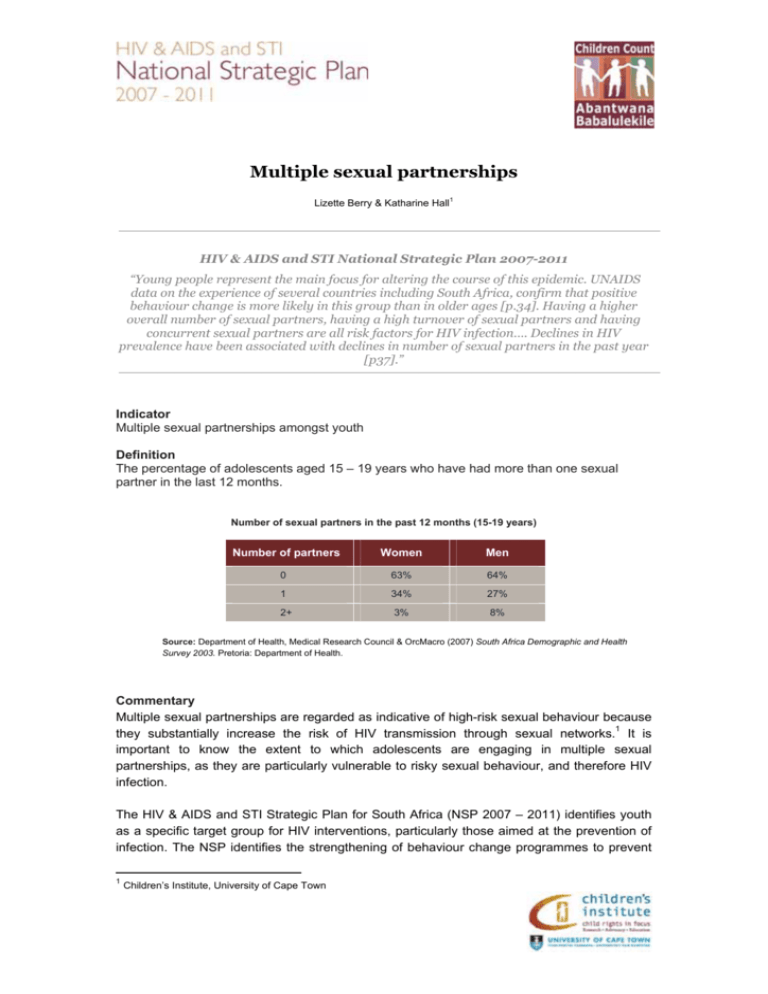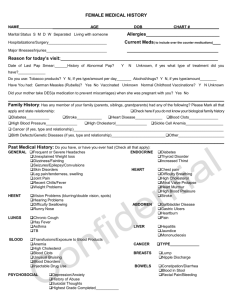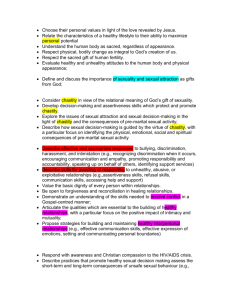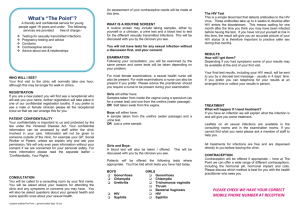
Multiple sexual partnerships
Lizette Berry & Katharine Hall
1
HIV & AIDS and STI National Strategic Plan 2007-2011
“Young people represent the main focus for altering the course of this epidemic. UNAIDS
data on the experience of several countries including South Africa, confirm that positive
behaviour change is more likely in this group than in older ages [p.34]. Having a higher
overall number of sexual partners, having a high turnover of sexual partners and having
concurrent sexual partners are all risk factors for HIV infection…. Declines in HIV
prevalence have been associated with declines in number of sexual partners in the past year
[p37].”
Indicator
Multiple sexual partnerships amongst youth
Definition
The percentage of adolescents aged 15 – 19 years who have had more than one sexual
partner in the last 12 months.
Number of sexual partners in the past 12 months (15-19 years)
Number of partners
Women
Men
0
63%
64%
1
34%
27%
2+
3%
8%
Source: Department of Health, Medical Research Council & OrcMacro (2007) South Africa Demographic and Health
Survey 2003. Pretoria: Department of Health.
Commentary
Multiple sexual partnerships are regarded as indicative of high-risk sexual behaviour because
they substantially increase the risk of HIV transmission through sexual networks.1 It is
important to know the extent to which adolescents are engaging in multiple sexual
partnerships, as they are particularly vulnerable to risky sexual behaviour, and therefore HIV
infection.
The HIV & AIDS and STI Strategic Plan for South Africa (NSP 2007 – 2011) identifies youth
as a specific target group for HIV interventions, particularly those aimed at the prevention of
infection. The NSP identifies the strengthening of behaviour change programmes to prevent
1
Children’s Institute, University of Cape Town
sexual transmission of HIV, and the implementation of interventions targeted at reducing HIV
infection in young people, as two key objectives. One of the NSP’s main targets is to reduce
the rate of new HIV infections by 50% by the year 2011. An intervention package linked to this
target, the HIV prevention programme, includes a focus on safer sex practices and
decreasing sexual partner numbers. Life skills and HIV prevention programmes implemented
at educational institutions is also a key strategy proposed by the NSP.2
Although the South African Demographic and Health Survey (SADHS) 2003 pre-dates the
implementation of the NSP, it provides an indication of the extent to which adolescents are
engaging in multiple sexual partnerships. Programmes and interventions targeted at young
people should continue to encourage and foster the development of safe sexual practices.
Particular attention should be given to adolescent males, who are found to be particularly
vulnerable to HIV infection through multiple sexual partnerships.
Only 3% of young women in the 15 – 19 year age group reported having more than one
sexual partner in the previous year, as opposed to 8% of males3. Although this is a relatively
low proportion compared with older age groups, the prevalence of multiple partners among
male adolescents suggests that they (and their sexual partners) may be more at risk of HIV
infection.
The SADHS 2003 disaggregates the data to show differences between people who are in a
union with a permanent partner (married or co-habiting) and those who are not. However,
these disaggregations are not sufficiently reliable for the 15 – 19 age group due to the small
number of sampled respondents who were defined as being in unions. In the upper age
groups, those who were in a union at the time of the survey were less likely to report multiple
partnerships than those who were not married or cohabiting. Overall, only 2% of women and
7% of men who were in a union reported having more than one sexual partner in the previous
year. The figure increased substantially for men who were not in a union (19%), but remained
low for women (3%). The highest rate of reported multiple partnerships is for young men in
their early and late twenties, where 24% report having multiple partners.
Strengths and limitations of the data
Two nationally representative South African Demographic and Health Surveys (SADHS) have
been conducted to date. These cover the population living in private households. The first
was conducted in 1998, and the second in 2003. The main survey targets women aged 15
and 49 years.
Both the 1998 and 2003 surveys use two-stage nationally representative probability samples,
drawn from Census enumeration areas. The sample is first stratified by the country’s nine
provinces, and then by urban and non-urban areas. The final sample yielded approximately
12,000 households for the 1998 survey and 10,000 households for 2003.
There was a marked decline in the response rate to the survey. The overall response rate for
the women’s questionnaire was 75% in 2003, far lower than the 92% in 1998. Western Cape
had the highest number of women who refused to be interviewed. The response rate for the
adult survey (which includes men) was 71% in 2003, again lower than the 90% response rate
in 1998.
The SADHS 2003 report suggests an over-representation of urban areas and of the African
population group, and an under-representation of Whites and Indian females. It also highlights
problems with age misreporting.
Key demographic and adult health indicators from the SADHS 2003 have data quality
problems, which may be the result of poor fieldwork. These include child mortality, fertility and
hypertension prevalence estimates. These indicators are either inconsistent with other data
sources or difficult to interpret. Findings that are not sufficiently robust for decision-making are
indicated in the report.
September 2009
References
1
Shisana O, Rehle T, Simbayi LC, Zuma K, Jooste S, Pillay-van-Wyk V, Mbelle N, Van Zyl J,
Parker W, Zungu NP, Pezi S & the SABSSM III Implementation Team (2009) South African
national HIV prevalence, incidence, behaviour and communication survey 2008: A turning
tide among teenagers? Cape Town: HSRC Press.
2
Department of Health (2007) HIV & AIDS and STI Strategic Plan for South Africa 2007 –
2011. Pretoria: Department of Health.
3
Department of Health, Medical Research Council & OrcMacro (2007) South Africa
Demographic and Health Survey 2003. Pretoria: Department of Health.







